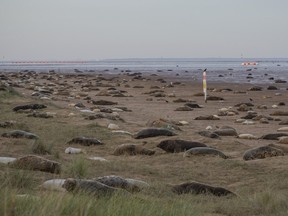H5N1 virus linked to seal deaths in St. Lawrence raises questions about potential risks to humans and future pandemics.

The infection of mammalian species by avian flu viruses is causing concern, with cell replication in mammals making the virus more pathogenic to humans.
A recent investigation into the increase in deaths among seal populations in the St. Lawrence River in 2022 shed light on this risk.
Between April 1 and Sept. 30, 2022, 209 dead or sick seals were reported in the Estuary and Gulf of St. Lawrence. The increase in summer deaths among harbour and grey seals was almost four times greater than historical data. For several specimens, the H5N1 strain of avian flu was identified as the cause of death.
The results of a survey published in the Centers for Disease Control and Prevention (CDC) suggest the presence of large numbers of H5N1-infected bird carcasses at seal landing sites most likely contributed to the spread of infection to pinnipeds. But current data is insufficient to determine whether seal-to-seal transmission has occurred.
“In the epidemic we saw in 2022 in harbour seals, especially, there doesn’t seem to be any evidence that the virus was transmitted from one seal to another,” explained survey co-author Stéphane Lair. “What we can assume is that the disease was so acute, the death was so rapid, that the animals didn’t have time to excrete the virus for very long.”
However, the current H5N1 strain has caused “very significant” deaths in pinnipeds, especially sea lions in South America.
“We’re talking about several thousand animals that have died, which suggests that in these cases, there have been transmissions from one sea lion to another. And in these herds of sea lions, they have a lot more close contact with each other, which may have favoured this kind of direct transmission between sea lions,” Lair said.
His work highlights the fact marine mammals could act as reservoirs for the H5N1 avian flu virus, which could increase the risk of mutations leading to infection of new mammalian hosts. Consequently, surveillance of this virus in wild marine mammal populations is essential to assess the public health risk associated with this emerging pathogen-host dynamic, the CDC report said.
In Quebec, the Canadian Food Inspection Agency recently conducted two investigations relating to avian influenza in domestic birds. The infection was detected on Nov. 17 and 18 on two poultry breeding sites in Montérégie.
A first case of H5N1 avian flu in humans in Canada was confirmed last week in British Columbia.
No need to panic, experts say
According to two experts, we should not panic at the virus being transmitted to humans because cases are so few.
“There have already been reported cases in humans,” said Lair, who is also a professor at the Faculty of Veterinary Medicine at the Université de Montréal. “These are fairly limited cases in terms of number, which suggests that this virus is not very well adapted to humans.
“What we need to understand with influenza viruses is that they make recombinations between viruses, mutations. And so, they can change over time. The one currently circulating in North America is a Eurasian strain, which is different from the Asian one that has caused several human cases. This strain seems much less likely to be transmitted among humans than the Asian strain,” he explained.
According to Lair, more worrying is the fact this virus can mutate and do not know what future generations of the virus will have as an adaptation.
“Public health is always a little more concerned when this avian virus starts infecting mammals such as seals, because it shows that there is a certain adaptation to mammalian cells, and since we are mammals, we can ask ourselves: are we next on the list?”
Brian Ward, professor in the Department of Medicine at McGill University and co-director of the Vaccine Centre of the MUHC, is also moderately concerned.
“It’s worrying, but at a low level,” he said.
“In recent years, there have been cases in elephant seals, farm animals and domestic birds. But in wild birds, especially seabirds, geese and ducks, these viruses have been circulating actively for decades. We now have histories of multiple clades, and there are mutations that make transmission to mammals easier,” Ward said.
So far there have been no cases of human-to-human transmission.
“There’s not a huge signal that this is going to change quickly,” Ward said.
“Transmission in birds is mainly via the faecal oral route, so faeces contain the virus. There are birds around seals. Aerosols are formed in these environments. It’s possible that even without a receptor, which is appropriate in an infection, the seal could fall ill because of the intensity of the aerosols,” Ward said.
Lair and Ward agree the next pandemic could be avian influenza. But they don’t think we need to worry too much.
“No panic at the moment, but we need to use this moment, while these viruses have our attention. We need to use this motivation to be better prepared when one of these viruses comes out, or another virus like SARS-CoV-2. We need to be prepared for the next pandemics, because they’re inevitable,” Ward said.